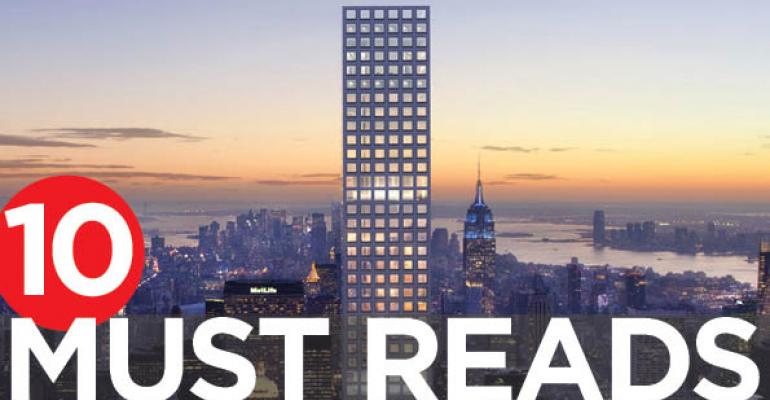- U.S. Judge Rejects 14 Banks’ Bid to Throw Out Rate-Rigging Lawsuit “A federal judge in Manhattan on Monday rejected an effort by 14 of the world's biggest banks to throw out a private lawsuit accusing them of rigging an interest rate benchmark used in the $553 trillion derivatives market. U.S. District Judge Jesse Furman said investors led by several pension funds and municipalities could pursue federal antitrust claims over an alleged conspiracy to rig "ISDAfix" from 2009 to 2012, and breach of contract and unjust enrichment claims against most defendants. Other claims were dismissed.” (Reuters)
- Why Marriott Can’t Win its Battle with a Chinese Rival “Marriott's big disadvantage in this fight is that while Anbang's offer is all in cash, its offer is based primarily on stock — and investors have knocked the value of that stock back. Because Marriott was counting on using shares to fund most of the deal (only about $3.6 billion of its $13.6 billion offer is in cash), the company is still not free, as Anbang is, to boost its offer without worrying about what its stock is doing.” (Business Insider)
- Deutsche Bank, JP Morgan Team Up for $818M CMBS Deal “Deutsche Bank and JP Morgan have teamed up for the first time since the crisis to underwrite a conduit commercial mortgage bond by themselves, according to investors and syndicate sources. The $818 million deal includes only loans made by Deutsche and JP Morgan, whereas most conduit deals sold in the past five years have included collateral from much smaller, non-bank lenders that are known for making riskier loans.” (The Economic Times)
- Elaine Wynn Files Suit to Gain Control of Casino Company Shares “Elaine Wynn, the ex-wife of Wynn Resorts Ltd. founder Steve Wynn, filed suit in a Nevada state court seeking to gain control over her shareholdings in the casino company. Chief Executive Officer Steve Wynn breached their January 2010 stockholder agreement, Elaine Wynn said Monday in a statement. She accused her ex-husband of orchestrating her ouster from the board in retaliation for asking questions about the ‘tone at the top,’ the absence of appropriate internal controls, the withholding of information from the board and alleged reckless activity of the CEO and others in the company.” (Bloomberg)
- This Real Estate Market is Heading for a Crash “The tallest residential structure in the Western Hemisphere sits at 432 Park Avenue in New York City. Standing at nearly 1,400 feet, there are 141 apartments for sale in a building where there average selling price is $21 million, ten times the price of an ‘average’ Manhattan apartment! But here's the thing, despite all the amenities, the views and the allure this building may have, the super rich do not appear to be knocking down any doors to get in.” (CNBC)
- O’Neill Properties Group Begins Construction on $2.2 Billion Project “O’Neill Properties Group announced that it has completed brownfield remediation project at the 40-acre lagoon at The Pointe located in Sayreville, New Jersey. The Pointe is the largest mixed-use brownfield redevelopment ever undertaken in the Northeast with the project costs of $2.2 billion. Vertical construction will begin in spring 2016 on a 200,000-sq. ft. anchor tenant Bass Pro Shops Outdoor World, the largest Bass Pro in the country outside of its original flagship operation.” (Chain Store Age)
- IDS Center, Tallest Building in the State, is Up for Sale Again “Chicago-based Holliday Fenoglio Fowler announced Monday it is marketing the 57-story, 1.43 million square feet tower, which has been owned for three years by Accesso Partners, a Florida real estate firm. Built in 1972, the tower was designed by influential American architect Philip Johnson. It is currently 88 percent leased. Accesso, then known as Beacon Investment Properties, bought the IDS Center for $253 million in April 2013 and has since invested in several upgrades, including a free fitness center, conferencing space and other amenities.” (Star Tribune)
- Google and Apple: The High-Tech Hippies of Silicon Valley “For all the talk of ‘disruption’ coming out of Silicon Valley, one thing that has tended to remain stubbornly stuck in the past is tech companies’ architecture. Many of today’s most innovative companies are housed in deadly dull, boxy and glassy suburban campuses: Google lives in the rehabbed buildings of long-defunct Silicon Graphics, Facebook in a laboratory from the 1960s. Though the interiors might have advanced lighting systems, state-of-the-art fitness facilities and cafeterias serving farm-to-table fare, the exteriors could come from any suburban office corridor anywhere in the country, and from any moment in the past half-century.” (The New York Times)
- City Levies Fines, but Fails to Collect Over Half-Billion from Landlords “Steven Croman holds the dubious distinction of having ended 2015 with more than $1 million in unpaid building- and construction-code violations on properties he owns in New York City, according to research by the Cooper Square Committee, a tenants' rights group. The fines that Croman and his firm, 9300 Realty, had accrued showcase the city's inability to collect about $1.6 billion in quality-of-life fines, known as Environmental Control Board (ECB) violations.” (Crain’s New York Business)
- Why Millennials are About to Leave Cities in Droves “There’s mounting evidence that millennials’ love of cities was a passing fling that became a shotgun wedding thanks to the Great Recession. Millennials don’t love cities any more than previous generations, the counterargument goes—they’ve just been stuck there longer, pining for the suburbs all the while. The latest contrarian volley comes from Dowell Myers, an urban planning professor at USC. Demographer William Frey has been arguing for years that millennials have become ‘stuck’ in cities by the 2008 downturn and the following slow recovery.” (Fortune)
0 comments
Hide comments

